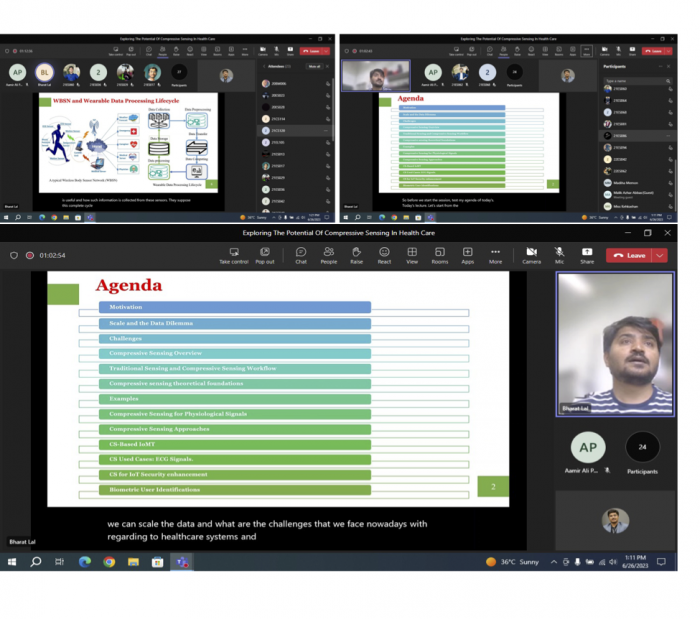- University
- Academics
- Admissions
- Departments
- Institutes
- Directorates
- Innovation & Entrepreneurship Center (IEC)
- Coal Research & Resource Center
- Office of Research, Innovation & Commercialization (ORIC)
- Centre of English Language & Linguistics
- Information & Communication Processing Center
- Management Information Systems
- Planning & Development
- Postgraduate Studies
- Quality Enhancement Cell
- Sports
- Directorate of Finance
- Research
- Sustainability
Report: Session on Exploring the Potential of Compressive Sensing in Healthcare
15/08/2023 - 11:01am
INTRODUCTION
On 26th June, 2023, a highly informative session on "Exploring the Potential of Compressive Sensing in Healthcare” was conducted by Professor Bharat Lal, a PhD Scholar at the University of Calabria, Italy . The online session was organized by IEEE IMS Student Branch in collaboration with IEEE EMBS, Electronic Engineering department, MUET Jamshoro. It witnessed the active participation from IEEE as well as non IEEE members. The session aimed to provide insights into the application of compressive sensing (CS) techniques in the healthcare domain. The session was hosted by M. Hadeed, chair of IEEE IMS and outstandingly volunteered by IMS team.
SESSION OVERVIEW
Sir Bharat began the session with an introduction to compressive sensing, highlighting its core principles and advantages in data acquisition and reconstruction and delved into the potential of CS techniques to revolutionize healthcare by reducing data acquisition costs, enhancing imaging capabilities, and enabling new diagnostic and monitoring methods.
KEYPOINTS:
FUNDAMENTALS OF COMPRESSIVE SENSING:
The speaker provided a comprehensive overview of the fundamental concepts of compressive sensing. He explained the mathematical principles behind CS and how it enables the reconstruction of sparse signals from fewer samples than traditional methods. This understanding set the foundation for the subsequent discussions.
COMPRESSIVE SENSING IN MEDICAL IMAGING:
The speaker also focused on the application of compressive sensing in medical imaging. He highlighted how CS can significantly reduce the number of samples required for imaging, leading to faster acquisition times, reduced radiation exposure, and improved patient comfort. Various imaging modalities, including MRI, CT, and ultrasound, were discussed in the context of CS.
REMOTE MONITORING AND WEARABLE DEVICES:
The speaker explored the potential of compressive sensing in remote monitoring and wearable devices. It was discussed that how CS techniques can optimize data transmission and processing in real-time healthcare monitoring applications. The speaker shared examples of wearable sensors and biosignal monitoring systems that leverage CS to achieve efficient data collection and analysis.
Q&A SESSION:
After the presentations, the session opened for a question-and-answer segment. Attendees actively participated, seeking clarification on technical aspects, potential limitations, and practical implementation challenges of compressive sensing in healthcare.
CONCLUSION:
The online session on "Exploring the Potential of Compressive Sensing in Healthcare" provided a comprehensive overview of the application of compressive sensing techniques in the healthcare domain. The speakers highlighted the benefits of CS in medical imaging, remote monitoring, and wearable devices. The session fostered knowledge exchange, collaboration, and identified potential research areas to overcome challenges and realize the full potential of compressive sensing in healthcare.

- Section:
